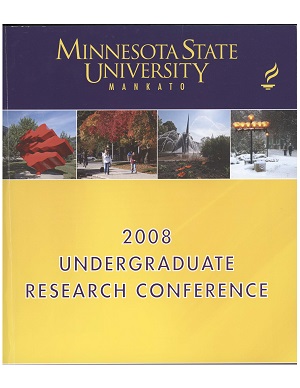Assessing the Campus Climate at Minnesota State University, Mankato (MSU)
Location
CSU 253/254
Start Date
22-4-2008 8:30 AM
End Date
22-4-2008 10:30 AM
Student's Major
Ethnic Studies
Student's College
Social and Behavioral Sciences
Mentor's Name
Kebba Darboe
Mentor's Department
Ethnic Studies
Mentor's College
Social and Behavioral Sciences
Description
Since 2003, the student population at Minnesota State University, Mankato (MSU) has increased by 4.1 %, resulting in more non-white students. Consequently, the researcher felt a need to assess the campus climate to determine whether the educational and social climate is welcoming to a diverse student body. Therefore, the increase .in the racial/ethnic diversity of the student population is the impetus of this study. MSU has a total population of approximately 14,000 and a sample size of 255 students was used for this study. The data was collected using a questionnaire consisting of 31 questions. The questions focus on demographics as well as attempting to determine how welcoming the campus is to a diverse student body. Data for the questionnaire was analyzed using the computer software program, SPSS. A non-parametric statistical test called chi-squared was used to test seven hypotheses and determine whether there is a significant difference between student diversity and the welcoming environment of the university. Additionally, a focus group consisting of students from freshman through senior years was used to provide more in-depth responses to questions which the researcher felt had not been thoroughly answered in the quantitative data obtained from the questionnaires. The findings from the hypothesis testing were also strengthened by the findings from the focus group. Results indicate that there is a statistically significant relationship between the number of friends of a different ethnicity and racial campus climate. There is also a statistically significant relationship between stereotyping and racial campus climate. There is also a statistically significant relationship between free speech and racial campus climate. In summary, the researcher recommends a continuing dialogue between students, faculty and staff to address race relations issues.
Assessing the Campus Climate at Minnesota State University, Mankato (MSU)
CSU 253/254
Since 2003, the student population at Minnesota State University, Mankato (MSU) has increased by 4.1 %, resulting in more non-white students. Consequently, the researcher felt a need to assess the campus climate to determine whether the educational and social climate is welcoming to a diverse student body. Therefore, the increase .in the racial/ethnic diversity of the student population is the impetus of this study. MSU has a total population of approximately 14,000 and a sample size of 255 students was used for this study. The data was collected using a questionnaire consisting of 31 questions. The questions focus on demographics as well as attempting to determine how welcoming the campus is to a diverse student body. Data for the questionnaire was analyzed using the computer software program, SPSS. A non-parametric statistical test called chi-squared was used to test seven hypotheses and determine whether there is a significant difference between student diversity and the welcoming environment of the university. Additionally, a focus group consisting of students from freshman through senior years was used to provide more in-depth responses to questions which the researcher felt had not been thoroughly answered in the quantitative data obtained from the questionnaires. The findings from the hypothesis testing were also strengthened by the findings from the focus group. Results indicate that there is a statistically significant relationship between the number of friends of a different ethnicity and racial campus climate. There is also a statistically significant relationship between stereotyping and racial campus climate. There is also a statistically significant relationship between free speech and racial campus climate. In summary, the researcher recommends a continuing dialogue between students, faculty and staff to address race relations issues.
Recommended Citation
Brush, Alicia. "Assessing the Campus Climate at Minnesota State University, Mankato (MSU)." Undergraduate Research Symposium, Mankato, MN, April 22, 2008.
https://cornerstone.lib.mnsu.edu/urs/2008/oral-session-11/1



